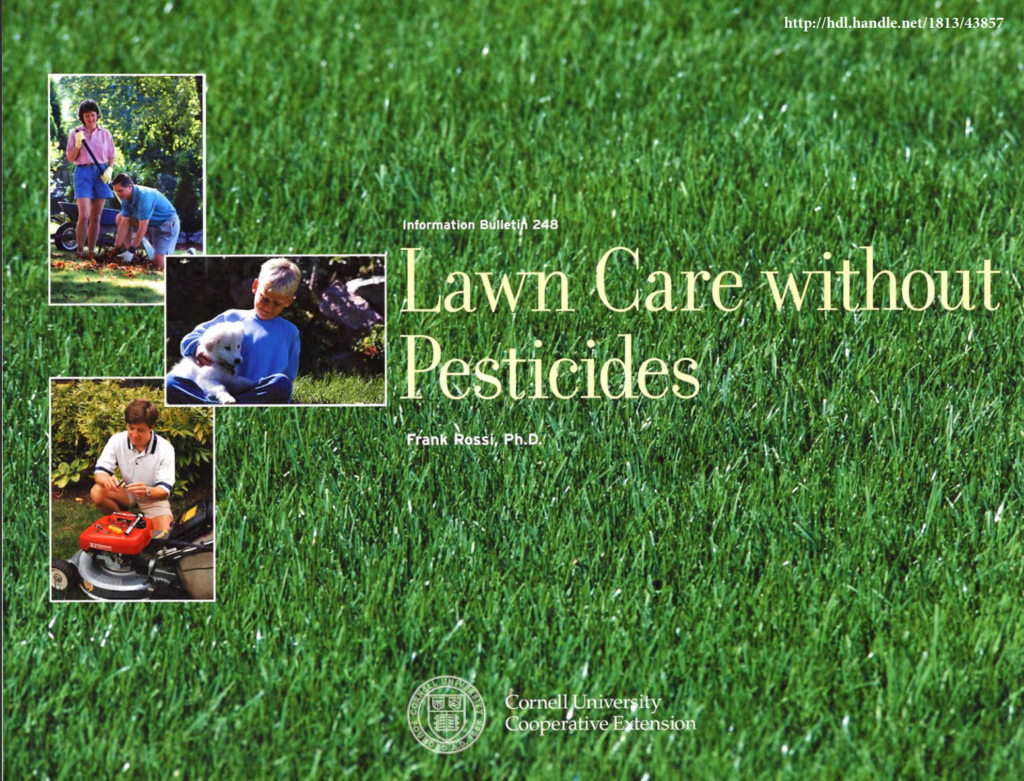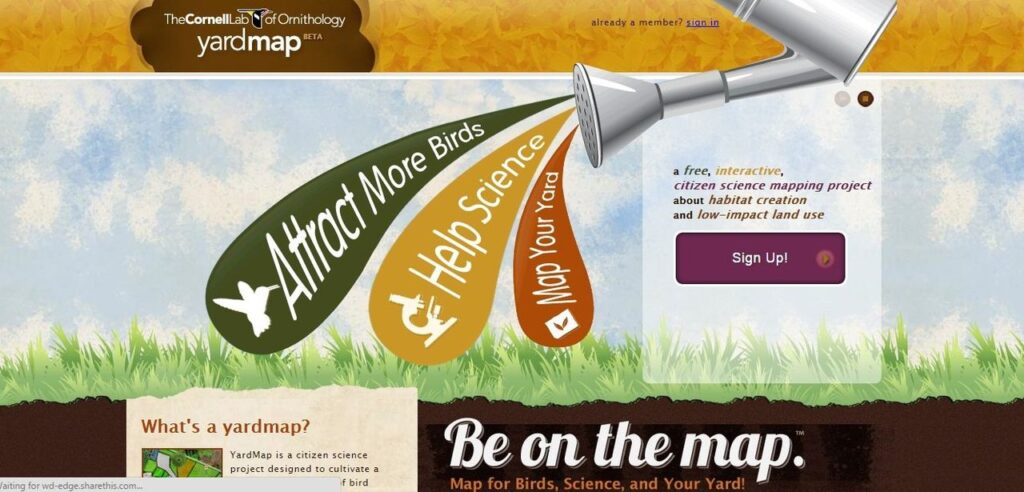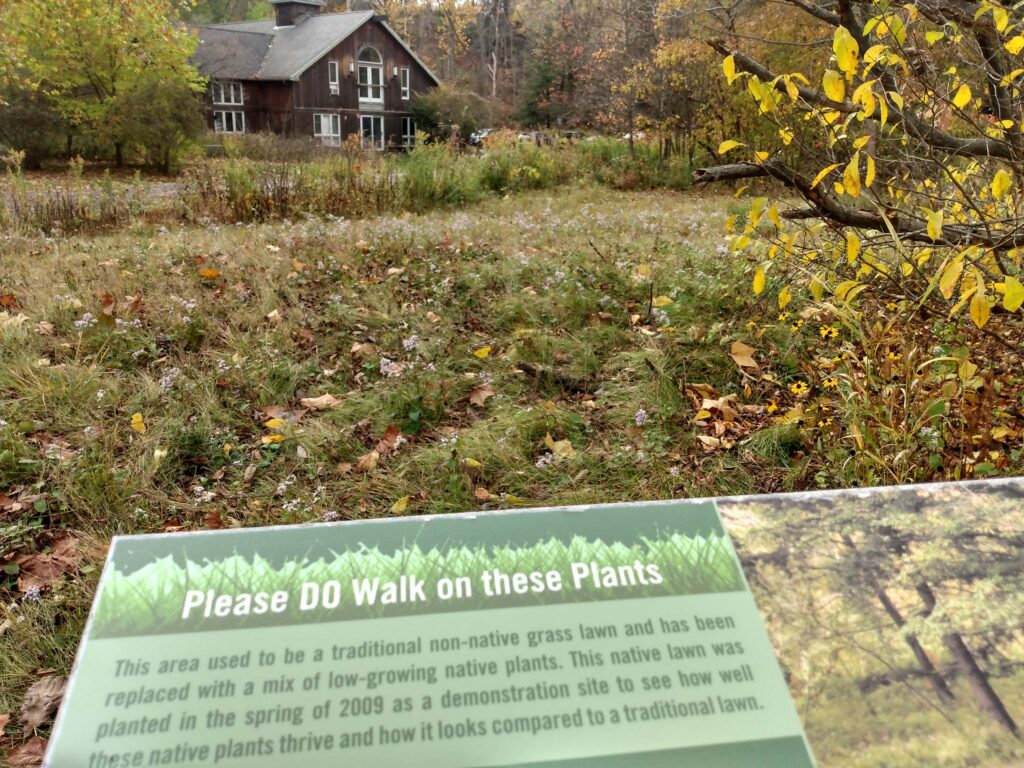Other Kinds of Solutions: Institutional
Some solutions related to environmental sustainability may happen at an institutional level through the actions of entities like colleges and universities, religious organizations, and large businesses. According to chapter ten of Sustainable Solutions by Richard Niesenbaum, there are two main types of institutions: business and educational. A modern institutional solution to lawn care is Cornell University’s Turfgrass Program. This elaborate educational institution is based in Ithaca, New York and has several Cooperative Extension programs throughout the state. The Cornell Cooperative Extension “is a dynamic education system connecting Cornell’s world-class research with regional and county-based educators and partners across the state. With a presence in every county and all five boroughs of New York City, CCE is uniquely positioned to tailor opportunities and resources to match the diverse and ever-evolving needs of individual communities across the state.”1 CCE has over sixty agricultural specialists statewide and is partnered with approximately 400 members of Cornell’s faculty and staff.2 The team of specialists working with Cornell’s Turfgrass program are committed to improving the environment by helping and educating homeowners, sports-turf and golf-turf professionals, sod producers, and others develop sustainable ways of managing their turfgrass. The Cornell Turfgrass Program works in partnership with the New York State Turfgrass Association (NYSTA), who offers turfgrass management and important information regarding public policy involving lawn care.3

Source: The Cornell Turfgrass Program a
Cornell’s website for their Turfgrass Program is expansive and offers current news about lawns, tips and tricks for sustainably caring for turfgrass lawns, information about weeding and pesticide use, and more.4 There are also menus specifically for sports and golf turfs with access to similar information and resources. The website has a myriad of educational webinars posted in three main topics: Golf, Lawn and Landscape, and Sports turf, and can often be replayed in the format of podcasts.5 There is a section labeled Environment, which provides environmental news related to turf management, water conservation, the reduction of chemical use, pollinator protection, and more.6 Another helpful tool on the Cornell Turfgrass Program’s website are their resources for pest and weed control. There are several helpful guides involving pest management, common turfgrass diseases, insect and weed identification, as well as diagnostic services for soils, insects, diseases, and plant pathology.7 Cornell states that in order to achieve a lawn that is both environmentally conscious and aesthetically pleasing, the four steps to success are: knowing your lawn, making adjustments, doing less maintenance, and using alternative groundcovers.8 Each of these four steps are linked to pages with information about the structural characteristics of lawns, tips on how to make weeding and mowing more environmentally friendly, guides on when/how to apply fertilizer and water, and potential alternatives to traditional grass lawns.

Source: Lawn Care Without Pesticides by Frank Rossi, Cornell turf grass specialist (2005) b
Cornell University has some helpful online resources like ForeCast: Weather for the Turf Industry and YardMap. The turf forecast tool provides a number of graphics such as Risk Maps for common turfgrass diseases, as well as maps for weed accumulation, rainfall, temperature, moisture deficit, and much more.9 YardMap is a tool from Cornell’s Lab of Ornithology that allows individuals to “quickly and easily make free maps of verdant places such as their home or a local cemetery, marking out lawns, trees and other landscape features over a satellite view. Researchers use map data matched with bird sightings, which can be submitted using the eBird tool on the site, to study the impact of backyards on migrating birds as they crisscross North America. Tools on the YardMap website help users learn more about how planting practices can attract more birds and other wildlife.”10 The tool is free to use and based on location in order to provide accurate information based on factors like climate, soil health, and bird populations.

Source: YardMap infographic from The Cornell Lab of Ornithology c
Cornell University enacts sustainable practice on its campus as well. Their Botanic Gardens Native Lawn was planted in 2009 and was a direct effort “to demonstrate how well native plants thrive and can perform as meadow areas, with fewer pesticides and chemicals. The site was used as a model for high-performing replacement for traditional lawns.”11 This native space is planted with a mix of low-growing grasses, thirteen species of forbs, and woodland and meadow herbs. Each year, the lawn is expanded upon and requires “less irrigation and [is] more likely to be resistant to weeds, pests, and fungus.”12 The university also has a Sustainable Landscapes Trail, which is composed of more than a dozen sites around campus that were designed for “maximum sustainability, ecosystem services, and natural beauty.”13 Each highlighted location has a sign that links to the trail’s main website, where visitors can learn more about the sustainable features and construction at the site. The trail was opened to the public in 2018 and offers individuals with natural, serene areas that are both aesthetically pleasing and sustainably created. Each site was designed with the help of faculty, staff, students, and researchers in cooperation with Cornell’s Plant Science Department. The trails are characterized into the groups: Animals & Pest Management, Bioswales & Water, Sites Using Cornell “CU Soil”, Innovative Gardens, Green Roofs, and Lawns.14

Source: Native Lawn in the Mundy Wildflower Garden. Sustainable Landscapes Trail, Cornell University. d

Source: Cornell class planting native seeds in the Mundy Wildflower Garden. e
Cornell University defines sustainable landscaping as a vision that encompasses “a learning landscape” that will “demonstrate, monitor and interpret best practices in sustainable landscape planning, design and management” and “should highlight green infrastructure currently on campus and recognize that which could be utilized in the future as the campus develops.” It also states that it should “reduce stress and thereby increase physical and mental health in students through their engagement with nature, and to cultivate in students an increased appreciation of nature”, as well as “advocate for sustainable landscapes and practices early in the planning stages for new developments.”15
One of the limitations associated with Cornell University’s effort to make lawncare and landscaping more sustainable is the fact that they are only based in New York. Since they are a state institution, their target audience is somewhat limited. Despite the geographic barriers preventing widespread change towards sustainable turfgrass management, Cornell has a multitude of useful websites and interactive tools to make environmentally conscious landscaping more accessible. Their main stakeholders appear to be the students of Cornell and other New York State-funded universities, as their sustainable architecture, research, and resources strongly support student and staff involvement. Other stakeholders include land and homeowners, environmentalists, bird watchers, gardeners, park-goers, children and pets, landscape professionals, pest control specialists, and more.
Sources:
Biodiversity in Natural Areas | Sustainable Campus. sustainablecampuscornelledu. [accessed 2023 Apr 17]. https://sustainablecampus.cornell.edu/campus-initiatives/land-water/sustainable-landscapes-trail/biodiversity-natural-areas.
Botanic Gardens Native Lawn | Sustainable Campus. sustainablecampuscornelledu. [accessed 2023 Apr 17]. https://sustainablecampus.cornell.edu/campus-initiatives/land-water/sustainable-landscapes-trail/botanic-gardens-native-lawn.
Environment | Cornell Turfgrass Program. turfcalscornelledu. [accessed 2023 Apr 17]. https://turf.cals.cornell.edu/environment/.
Four Steps To Success | Cornell Turfgrass Program. turfcalscornelledu. [accessed 2023 Apr 17]. https://turf.cals.cornell.edu/lawn/lawn-care-the-easiest-steps-to-an-attractive-environmental-asset/four-steps-to-success/.
Lawn | Cornell Turfgrass Program. turfcalscornelledu. [accessed 2023 Apr 17]. https://turf.cals.cornell.edu/lawn/.
Lawn Care. Cornell Cooperative Extension. [accessed 2023 Apr 17]. https://genesee.cce.cornell.edu/gardening/lawn-care.
Know Your Lawn | Cornell Turfgrass Program. turfcalscornelledu. [accessed 2023 Apr 17]. https://turf.cals.cornell.edu/lawn/lawn-care-the-easiest-steps-to-an-attractive-environmental-asset/four-steps-to-success/know-your-lawn/
Pests & Weeds | Cornell Turfgrass Program. turfcalscornelledu. [accessed 2023 Apr 17]. https://turf.cals.cornell.edu/pests-and-weeds/.
Thatch | Cornell Turfgrass Program. turfcalscornelledu. [accessed 2023 Apr 17]. https://turf.cals.cornell.edu/lawn/lawn-care-the-easiest-steps-to-an-attractive-environmental-asset/advanced-care/thatch/.
Turf Grass Management. turfeascornelledu. [accessed 2023 Apr 17]. http://turf.eas.cornell.edu/#/.
See your lawn through a bird’s eyes with YardMap. 2014 Jun 11. [accessed 2023 Apr 17]. https://www.sciencenews.org/article/see-your-lawn-through-birds-eyes-yardmap.
Sustainable Lawns. Cornell Cooperative Extension. [accessed 2023 Apr 17]. https://allegany.cce.cornell.edu/gardening/lawns/sustainable-lawns.
Sustainable Lawns. Cornell Cooperative Extension. [accessed 2023 Apr 17]. https://tioga.cce.cornell.edu/gardening/lawns-ornamentals/sustainable-lawns.
Sustainable Landscapes Trail | Sustainable Campus. sustainablecampuscornell.edu. [accessed 2023 Apr 17]. https://sustainablecampus.cornell.edu/campus-initiatives/land-water/sustainable-landscapes-trail.
Webinars | Cornell Turfgrass Program. turfcalscornelledu. [accessed 2023 Apr 17]. https://turf.cals.cornell.edu/news-2/webinars/.
Weeds | Cornell Turfgrass Program. turfcalscornelledu. [accessed 2023 Apr 1
Writer CTB | C. 2015 Apr 17. YardMap from Cornell is a fun and easy online garden planner. syracuse. [accessed 2023 Apr 17]. https://www.syracuse.com/living/2015/04/yardmap_from_cornell_is_a_fun_and_easy_online_garden_planner.html.
Niesenbaum, R. Sustainable Solutions. Oxford University Press, 2020.